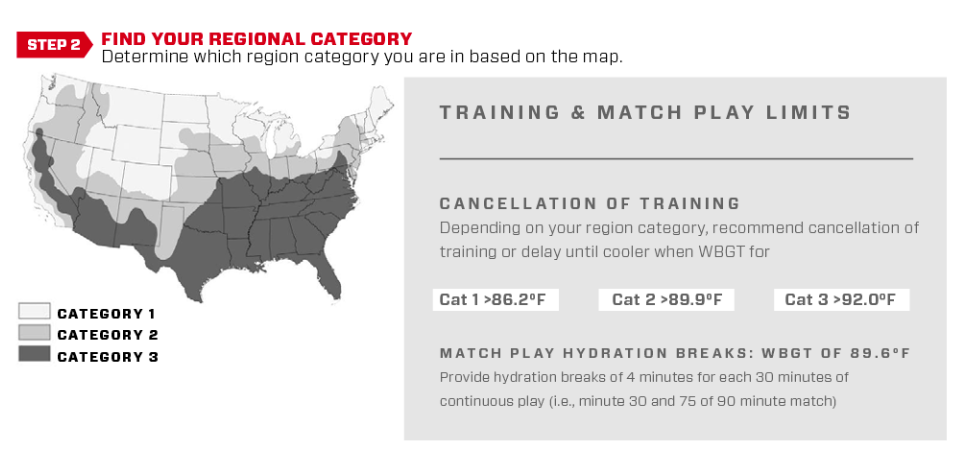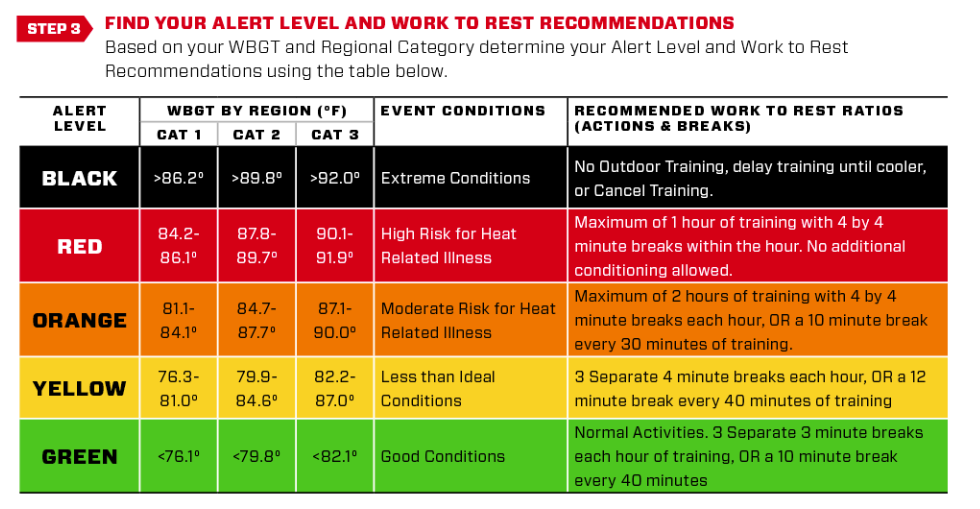Hot Weather Guidelines
Heat-related illnesses, such as heat stroke and heat exhaustion can be serious and potentially life-threatening conditions. U.S. Soccer’s RECOGNIZE TO RECOVER program prepared this guide for coaches, referees, and players when training or playing in warmer climates, outlining recommendations for hydration breaks and participant safety during extreme temperature conditions. The information provided herein is not a substitute for medical or professional care, and you should not use the information in place of a visit, consultation, or the advice of your physician or other healthcare provider. For specific questions and concerns, please consult your healthcare provider or physician.

RESOURCES TO HELP ENSURE SAFE PLAY
- WBGT monitor
- Hydration capabilities: water bottles, coolers, hoses, etc.
- National Weather Service Website: www.weather.gov
- Phone app for WBGT - WeatherFX (iTunes or Android Store)
- Ice
- Ice Immersion tub or kiddie pools
- Towels and cooler
- Tent or other artificial shade if none is available
HEAT-RELATED ILLNESS
Heat-related illnesses, such as heat exhaustion and exertional heat stroke (EHS), can be serious and potentially life-threatening conditions that can be brought on or intensified by physical activity. Recognizing the signs and symptoms as early as possible allows for treatment and rapid recovery with hydration and cooling down the individual.
• Early signs and symptoms of heat illness include weakness or fatigue, headache, nausea, and dizziness
• Altered mental status, such as confusion, irritability, aggressive behavior, dizziness
• Slurred speech
• Hallucinations
• Loss of balance, falling down
• Throbbing headache
• Body temperature above 104 degrees Fahrenheit
• Complaining of chills, while skin may be warm to the touch
Preventing heat-related illness is the best medicine. It may become important to adjust training, match play, and hydration breaks when playing in warmer climates and during extreme temperature conditions.
• Develop and implement a heat policy (heat acclimatization guidelines, activity modification guidelines based on environmental conditions, and management of heat-related illness) as part of your emergency action plan (EAP)
• Frequently monitor environmental conditions using Wet Bulb Globe Temperature (WBGT) device or Heat Index and make practice modifications (e.g., increase in the number and duration of hydration breaks, shortening practice, postponing practice/competition until cooler parts of the day)
• Follow heat acclimatization guidelines (below) during preseason practices and conditioning
• Ensure appropriate hydration policies are in place with athletes having unlimited access to water during practice and competition, especially in warm climates.
• Educate staff on the signs and symptoms of heat-related illness and early management
• Consider having a health care provider such as an athletic trainer onsite for all practices and competitions
To assist coaches and athletes in this, RECOGNIZE to RECOVER created an easy reference poster. The guidelines are intended to help evaluate situations to prevent heat-related illness before it begins. The three-step Heat Guidelines include methods for evaluating danger levels and appropriate responses to those various levels
EXCESSIVE HEAT IMPACT ON PLAY
Depending on your Region Category, it is recommended that training or match play be canceled or delayed until cooler when WBGT exceeds these levels:
• Region Category 1 >86.2°F;
• Region Category 2 >89.9°F
• Region Category 3 >92.0°F
Once an alert level is determined, follow these “Work to Rest” ratios to modify training to help ensure safe play:
• Alert Level Black – No outdoor training, delay training until cooler or cancel.
• Alert Level Red – Maximum of one hour of training with four separate 4 minute breaks within the hour. No additional conditioning allowed.
• Alert Level Orange – Maximum two hours of training time with four separate 4 minute breaks each hour, or a 10 minute break after 30 minutes of continuous training
• Alert Level Yellow – Use discretion, provide three separate 4 minute breaks each hour, or a 12 minute break every 40 minutes of continuous training
• Alert Level Green – Normal Activities, provide three separate 3 minute breaks each hour of training, or a 10 minute break every 40 minutes.
It is recommended to include scheduled hydration breaks when the WBGT reaches 89.6°F. Provide hydration breaks of four minutes for each 30 minutes of continuous play. In a regulation 90-minute match, this would schedule the hydration break at minute 30 and 75.
Provide adequate communication of environmental conditions, cooling methods and other resources to players and staff. This includes ensuring unlimited access to water and other fluids, making sure players and coaches are aware of planned breaks for hydration and the duration and time of training.
HEAT POLICY
A heat policy is intended to serve as a guide for regulating match play, practice sessions, hydration breaks and participant safety during extreme temperature conditions. Such a heat policy can be shared with participants, making sure everyone is aware of the safety precautions in place. The steps listed below should be considered when developing a heat policy:
• Heat policy should be part of an overall EAP
• Prevention
• Follow heat acclimatization guidelines (see box)
• Activity modification guidelines based on environmental conditions
• Frequently monitor environmental conditions
• WBGT device or Heat Index
• Increase the number and duration of hydration breaks
• Shorten practice/reduce intensity of exercises
• Postponing practice/competition until cooler parts of the day
• Management and treatment of heat-related illness
• Remove from training and source of heat
• Cool in a shaded area using ice towels, cooling tub or wading pool
• Provide access to fluids/electrolytes and encourage rehydration
• If emergency continues, call 9-1-1 for immediate medical assistance
• Ensure appropriate hydration policies are in place with athletes having unlimited access to water during practice and competition, especially in warm climates.
• Educate staff on the signs and symptoms of heat related illness and early management
• Consider having a healthcare provider such as an athletic trainer onsite for all practices and competitions
Acclimatization
Acclimatization is the body’s natural adaptation to exercising in the heat. This process typically takes 10-14 days. Effective acclimatization should require a gradual graded progression of exercise in the heat. This typically applies at the start of preseason (summer months) where athletes are beginning fitness training and progressive training exposure in heat is recommended
GUIDE FOR ACCLIMATIZATION (10-14 DAYS)
Avoid the hottest part of the day for training sessions (11am-4pm)
DAYS 1-5
• One formal practice a day
• Maximum three hours of training time (this includes warm up, stretches and cool down)
DAYS 6-14
• Double practice days can begin day 6 and not exceed five hours in total practice time between the two practices.
• Minimum of three-hour rest period between each training session during double practice days. The three-hour rest period should be in a cool environment to allow the body to fully recover.
• Each double practice day should be followed by a single practice day with practice time not to exceed three hours.
• Athletes should receive one day rest following six days of continuous practice.
RECOVERY
• Remove from training and away from the source of heat
• Cool in a shaded area using ice towels
• Fan or spray with water to bring down body temperature
• Provide access to fluids/electrolytes and encourage rehydration
IN SEVERE CASES OF EXERTIONAL HEAT STROKE:
• Remove excess clothing/equipment and immediately begin cooling the athlete by placing them in an ice-water tub
• If no tub is present, rotate cold, wet ice towels every 2-3 minutes over the entire surface of the body or as much as possible
• Call 9-1-1 – Exertional heat stroke is a medical emergency
SPECIFIC HEAT-RELATED ILLNESS
The first steps to recovery in all these cases are replacing fluids and cooling the body by resting in a cool, shaded place. Fanning or spraying with water will also help bring down the body temperature.
Heat Cramps
Heat cramps usually affect those who sweat a lot during strenuous activity. This sweating depletes the body’s salt level, as well as hydration. Low salt levels lead to painful muscle cramps. Heat cramps may also be a symptom of heat exhaustion.
Heat Exhaustion
Heat exhaustion is the body’s response to an excessive loss of water and salt, usually through excessive sweating. Someone suffering from heat exhaustion may appear confused or disoriented. It can lead to extreme weakness or fatigue, dizziness and nausea.
Heat Stroke
Heat stroke is the most serious heat-related disorder. It occurs when the body becomes unable to control its temperature. When this happens, the body’s temperature rises rapidly, the sweating mechanism fails and the body is unable to cool down. The surge in body temperature can happen very quickly, within 10 to 15 minutes, rising to 106° Fahrenheit or higher. Heat stroke can cause death or permanent disability if emergency treatment is not given.
Someone suffering heat stroke will be dizzy and confused. They may slur their speech, have hallucinations or complain of a throbbing headache. While their skin may be warm to the touch, they may actually complain of chills. If you suspect heat stroke, get the on-site medical provider or call 9-1-1.
MANAGEMENT
HEAT ILLNESS (HEAT EXHAUSTION, HEAT CRAMPS)
• Remove from training and source of heat
• Cool in a shaded area using ice towels
• Provide access to fluids/electrolytes and encourage rehydration
EXERTIONAL HEAT STROKE
• Is a medical emergency
• Immediately call EMS (911) and prepare hospital for heat related emergency
• Athlete may have confusion or altered mental status and a rectal temperature >104°F
• Remove excess clothing/equipment and immediately begin cooling the athlete by placing them in an ice-water-tub
• If no tub is present, rotate cold wet ice towels (every 2-3 minutes over the entire surface of the body or as much as possible)
Reference
http://www.recognizetorecover.org/environmental#heat-guidelines



